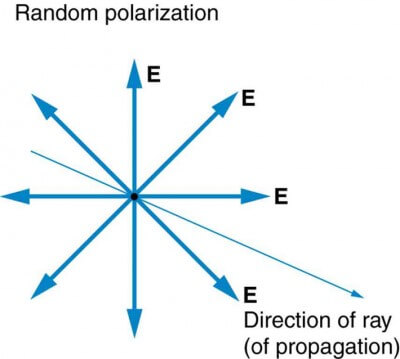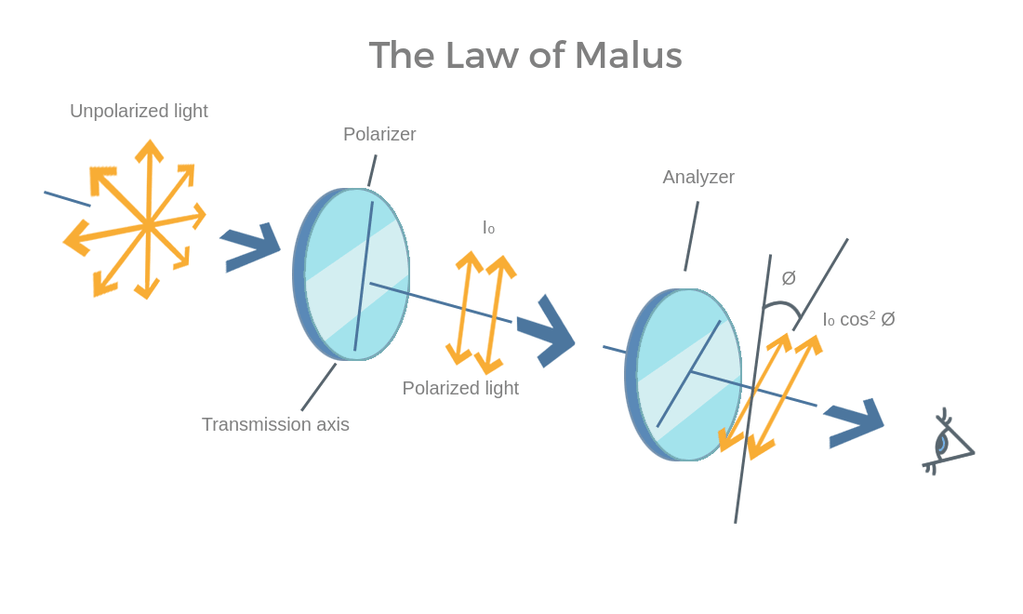With our Malus Law Calculator you will be able to calculate light intensity that passes through the polarization filter. In physics, there are two ways to treat light when we are talking about it:
- Light as multiple particles, photons with some amount of energy
- Light as a wave with certain energy
Both ways are technically correct, because in physics you can look at light as a wave or as a particle, but not as both at the same time. We will focus on definition in this article. We will also explore just the case of light (and not other types of electromagnetic waves).
Meanwhile, you can use our calculators to learn more about Kinetic Energy, or Elastic Potential Energy, but also head to our Acceleration Calculator to learn about the velocity, formula for velocity and acceleration. Also there is this Thin Lens Equation for you to learn more about lenses.
Polarization definition
Light is a transverse type of wave. That means that all points in a light wave oscillate in a line perpendicular to the direction of the light. Polarizing this type of wave means restricting oscillations to one direction.

After the filter wave should have one component depending on the angle of the polarizer.
Polarizer – how does it work
A polarizer is an filter that lets waves of certain polarization pass through while it blocks other components.

Before polarizer, light is unpolarized, which means that waves have components in all directions. For example, imagine you attached one end of the rope to the wall while holding the other end in your hand, far enough from the wall. If you move the hand with the rope up and down, you will create a polarized wave with only one axis of oscillation. Instead of moving your hand just up and down, imagine moving it randomly without moving it backward or forward. This wave has different random components to its oscillations and is unpolarized.
The transformation of an unpolarized wave to a polarized wave is polarization. Now, since we are talking about the polarization of light, you learned what is polarized light and now you wonder is finding suitable materials for polarizers a problem. So, we can divide them into two categories:
- Absorptive polarizers
- Beam-splitting polarizers
Absorptive polarizers absorb or reflect the light that isn’t supposed to be polarized. On the other hand, beam splitting polarizers fully polarize light (remaining waves don’t reflect). Read more about light polarization in this Brewster’s Angle Calculator.
Malus Law and equation
Let’s say we have two polarizers, one after the other in the direction of light. Technically, we call the second polarizer an analyzer. The axis of polarization of the two polarizers has a certain angle of incidence, theta, between them . Malus law states that the intensity of the light after the analyzer is equal to the intensity of the light before analyzer multiplied by the cosine theta squared or:
I=I_{0}\cdot cos^{2}\thetaWhere I is light intensity after the analyzer. I0 is light intensity before the analyzer. For calculating cos you could use our other calculators like Cosine Calculator.

Light intensity (in this case, radiation) is the derived quantity in the SI unit system. It’s unit is usually Watt per meter squared.
Difference between the polarizer and analyzer
The light that comes into the polarizer is often unpolarized and oscillating in every direction. The light that comes into the analyzer is polarized. That means it oscillates in just one direction. So, polarizer and analyzer are essentially the same things. We just use them in the different parts of the process. Analyzer always comes after the polarizer.
Malus Law Calculator – how to use?
When you open our app, the app will present you with a standard calculator. The app will present you with the search field when you touch that plus sign in the bottom right corner . In the search field, enter the name of the calculator. In this case, “Malus law calculator”.
Next, tap on the first auto-suggested option. You should now see the calculator interface with three fields: Initial intensity, Angle of incidence, and Intensity. If you enter the values in the first two fields, you should get the final light intensity in the last field. Our calculator supports various units so you could use watts per cm squared or radians as units.
Malus Law Calculator – example
Let’s say that you want to confirm Malus law experimentally. The light intensity of the sunlight varies between different geographic locations. Let’s say we are somewhere with light radiation of sun 1000 W per meter squared. For this experiment, you will also need two polarizer sheets, (look at the picture below).

Now face your polarizers toward the sun (staring into the sun for too long is bad for your eyes). Rotate them until light coming through reaches maximum intensity. Light coming through the first layer should have about 50 percent of initial intensity, 500 watts per meter squared. Therefore, light coming through the second layer (close to you) should also have the same intensity. That should be the case for:
\theta=0\space deg
Now, rotate the second layer for a certain number of degrees, using a protractor or some other tool. In our calculator, enter the data:
\text{Initial intensity}: 500 \times\frac{W}{m^{2}}\text {Angle of incidence: (angle that you chose)}As a result, you should see light polarized intensity coming through the analyzer in our calculator, calculated using the formula above.
Polarizers in real life
Physics is not only area where this law can be useful. One of the areas where polarizers can be useful is photography. They can remove glare from the sun, peeking through reflective surfaces, and accentuate black and white surfaces in the photo.
In addition, there are also special sunglasses with polarizing filters. They protect your eyes from that annoying glare effect you get when sunlight hits the road or water. We even use these filters every day without even knowing. For example, LCD monitors use polarizing filters to make the whole experience more pleasurable. You can study these phenomena in-depth and use our calculator to calculate the result.
FAQ
How do you use Malus law?
Malus law states that the intensity of the light after the analyzer is equal to the product of initial intensity and cos of the angle between polarizer and analyzer squared. So, to use it, you can plug your values into this formula to calculate the result.
What does Malus law state?
It states that the intensity of the light after the analyzer is equal to the product of initial intensity and cos of the angle between polarizer and analyzer squared.
What is a polarizer?
A polarizer is a kind of optical filter that lets only the component of light that aligns with its axis of polarization pass through.
Can a polarizer be used as an analyzer?
Polarizers and analyzers are essentially the same things. The difference is that polarizers are used for the polarization of unpolarized light, while the analyzers are used with the light that has already been polarized. So yes, a polarizer can be used as an analyzer.
What happens when the analyzer is placed parallel to the polarizer?
When the analyzer is placed parallel to the analyzer, we can change the angle of rotation of both layers to explore the effect of light intensity coming through the other layer.
